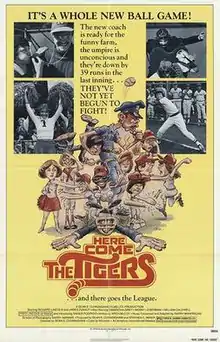| Here Come the Tigers | |
|---|---|
 Theatrical release poster | |
| Directed by | Sean S. Cunningham |
| Written by | Arch McCoy |
| Produced by | Sean S. Cunningham Steve Miner |
| Starring | Richard Lincoln James Zvanut Samantha Grey |
| Cinematography | Barry Abrams |
| Edited by | Steve Miner |
| Music by | Harry Manfredini |
Production company | Sean S. Cunningham Films |
| Distributed by | American International Pictures |
Release date |
|
Running time | 87 minutes |
| Country | United States |
| Language | English |
| Budget | $250,000[1] |
| Box office | $1 million[2] |
Here Come the Tigers is a 1978 American sports comedy film directed by Sean S. Cunningham.
Plot
"A wild team of misfits think that they can make it big. What's a coach to do with a chronic nose-picker, a flatulent fielder, an out of control pitcher, a juvenile delinquent and the prettiest girl in the state? Turn this bunch of losers into a winning team! When their new coach enlists an unusual new teammate, it's a whole new ballgame as they band together to win their first championship, determined to prove that losers can be winners, too."
Cast
- Richard Lincoln – Eddie Burke
- James Zvanut – Burt Honneger
- Samantha Grey – Bette Burke
- Manny Lieberman – Felix the Umpire
- William Caldwell – Kreeger
- Fred Lincoln – Aesop
- Xavier Rodrigo – Buster
- Sean Patrick Griffin – Art "The Fart" Bullfinch
Production
Cunningham said in Crystal Lake Memories: The Complete History of Friday the 13th (2005) he believed that the film cost $250,000 to make, "if that. It could be much lower. It was guerrilla filmmaking. It was all kids from the little leagues; it was like being on a three-week field trip with a bunch of sixth-graders. It was good and bad, frustrating and exciting. I loved it."[1]
Victor Miller, who wrote the film under the pseudonym Arch McCoy, said: "Those were the days when everybody said, 'What America needs is a good G-rated movie.' I guess Here Come the Tigers made its money back, but they lied about America wanting G-rated films."[1]
Reception
Variety called it a ripoff of The Bad News Bears (1976), trying to cash in on the success of the original and its sequel, with dull direction and dreadful acting.[3]
References
- 1 2 3 Bracke, Peter (October 11, 2006). Crystal Lake Memories. United Kingdom: Titan Books. p. 17. ISBN 978-1-845-76343-5.
- ↑ Donahue, Suzanne Mary (1987). American film distribution : the changing marketplace. UMI Research Press. p. 301. Please note figures are for rentals in US and Canada
- ↑ Hege. (May 31, 1978). "Film Reviews: Here Come The Tigers". Variety. p. 22.